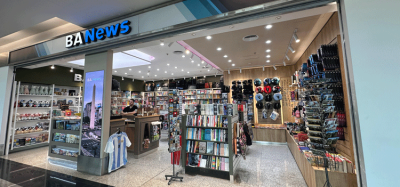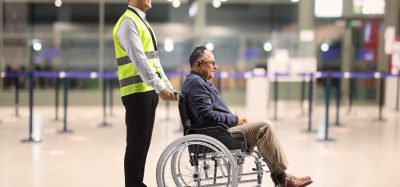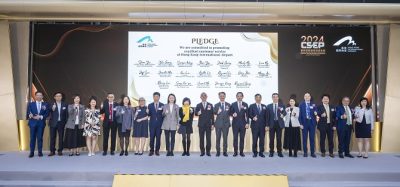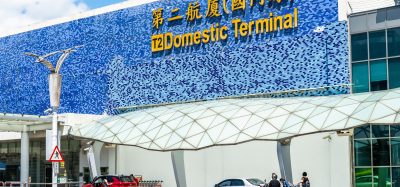Changi Airport increases safety measures following detection of COVID-19 cases
- Like
- Digg
- Del
- Tumblr
- VKontakte
- Buffer
- Love This
- Odnoklassniki
- Meneame
- Blogger
- Amazon
- Yahoo Mail
- Gmail
- AOL
- Newsvine
- HackerNews
- Evernote
- MySpace
- Mail.ru
- Viadeo
- Line
- Comments
- Yummly
- SMS
- Viber
- Telegram
- Subscribe
- Skype
- Facebook Messenger
- Kakao
- LiveJournal
- Yammer
- Edgar
- Fintel
- Mix
- Instapaper
- Copy Link
Posted: 25 May 2021 | International Airport Review | No comments yet
Following the detection of COVID-19 cases in its workforce and subsequently temporarily shutting down its passenger terminals, CAG has increased the safety measures that are in place throughout Changi Airport in order to protect staff, passengers and the community.
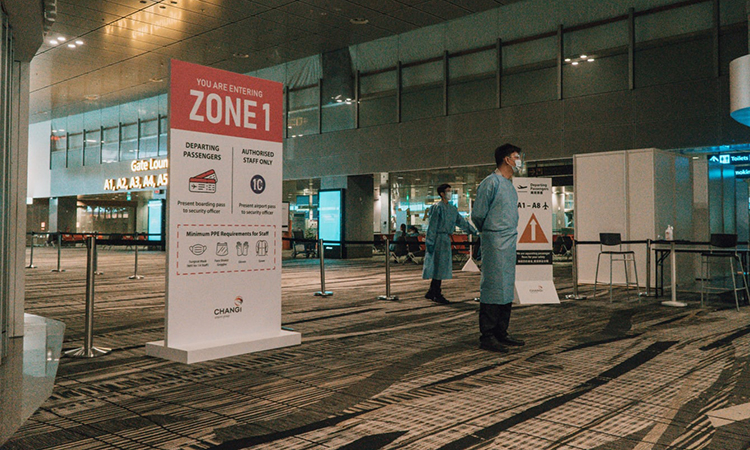

Credit: Changi Airport Group
Changi Airport Group (CAG), working closely with the relevant authorities, has announced new significant measures that it is implementing in Singapore Changi Airport’s (SIN) terminals to ensure that airport workers, passengers and visitors are well protected from the risks of COVID-19 transmission, even as the airport remains open for flight operations to keep Singapore connected to the world.
While Changi Airport had been able to keep its airport operations safe over the last 16 months through many layers of stringent safety protocols, the more virulent B1617 coronavirus strain has penetrated the airport’s defences, resulting in airport workers, their families and members of the public being infected.
The new measures being introduced follow an operational analysis of the recent outbreak. There will be additional infection control measures airport-wide in order to minimise the spread of the virus in light of the more transmissible COVID-19 variant. Protection for airport workers will be strengthened in the following ways:
- Segregation of the workplace, with strict access controls between zones and no mingling of workers between Zone 1 (highest risk) and the rest of the zones during shifts
- Enhanced level of personal protective equipment (PPE) protection for all workers in Zone 1, as well as strengthened protocols for the donning and doffing of PPE, with regular training and audits to reinforce the correct practices
- Ensuring all workers in Zone 1 are fully vaccinated
- Working towards daily non-invasive rapid testing of Zone 1 workers at the end of their shifts.
New safety measures at Changi Airport
New zoning concept
A new zoning concept is being introduced based on workers’ risk exposure. Under this concept, the airport’s terminals will be segregated into three zones.
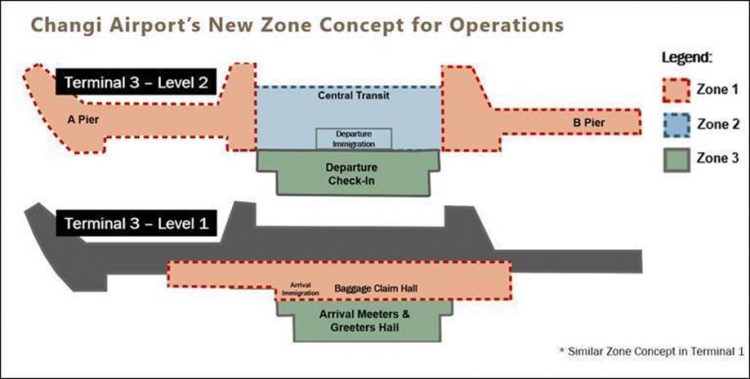

Credit: Changi Airport Group
Airport workers in Zone 1 (the terminal piers, arrival immigration hall and baggage claim hall) will be protected with the highest level of PPE and will be segregated from other workers throughout the duration of their shift. As an added precautionary measure, passengers from very high-risk countries will be escorted to remote gates in Terminal 2 for immigration clearance and then transported by bus out of Changi Airport directly to their quarantine facility, without going through the operational terminals.
Zone 1 workers will have their own dining areas with individual seating, rest areas, reserved toilets and dedicated PPE donning and doffing stations. Except during meal times or when using the toilet, they will have to be fully attired at the appropriate PPE level. All Zone 1 workers will remain within their work zone throughout their shift. Similarly, staff working in Zones 2 and 3 will have to comply with the applicable PPE requirements.
Personal protection for workers
It is important for airport workers to know and strictly follow the dos and don’ts of donning and doffing PPE. To achieve this, there will be additional training provided, with regular reminders from supervisors on PPE protocol. More audits and spot checks will also be carried out.
As vaccination provides the individual with protection and reduces the risk of transmission, only fully vaccinated staff will be rostered for duty in Zone 1. Additionally, CAG is aiming to have more than 90 per cent of workers in Zones 2 and 3 vaccinated as soon as possible.
A more robust testing regime will also be introduced to give Zone 1 workers added peace of mind. In addition to the Polymerase Chain Reaction (PCR) test every seven days, interspersed with the Antigen Rapid Test on the third day, daily rapid non-invasive testing to be carried out at the end of workers’ shifts is being planned. These measures will reduce the likelihood of an airport worker infecting close contacts at home.
CAG recognises the significant demands that the new zoning concept places on the workers, especially those working in Zone 1. It will work closely with its airport partners and agencies to ensure that workers’ welfare is taken care of.
Cleaner air in the terminals
The existing ventilation system in the terminals delivers one cycle of complete air change every six to 10 minutes in general spaces, and every three minutes in the toilets, comparable to the air change prescribed for swabbing test areas. Since the onset of COVID-19 in 2020, the air conditioning system supply air filters have also been upgraded from MERV-7-rated models to MERV-14-rated ones, which have higher filtration capabilities to better mitigate the risk of virus spread in alignment with the COVID-19 defence guidelines published by the authorities.
To further mitigate the risk of airborne transmission in Changi Airport’s terminals, CAG has installed portable air purifiers with High-Efficiency Particulate Air (HEPA) filters across key areas in the new segregated zones, focusing on more contained spaces where staff and passengers dwell, such as staff rest areas, changing rooms and gate holdrooms. These HEPA air purifiers are similar to those used in hospitals to sanitise the air.
Appreciation for airport workers
Changi Airport workers are without doubt at the frontline of the pandemic, facing risks every day. Some 14,000 workers are affected by the new measures being implemented, with 4,400 in Zone 1 alone. CAG is deeply appreciative of their dedication and resilience during these challenging times, and recognises that it is only through their unstinting efforts that Changi Airport can continue to operate safely and keep supplies coming into Singapore. With the new measures, Changi Airport and Jewel Changi Airport look forward to serving customers with confidence when they reopen to the public in June 2021.
Lee Seow Hiang, CEO of Changi Airport Group, said: “Changi Airport has been built on two pillars of strength – our strong connectivity, and our close community; firstly, among our airport partners, and secondly, with the people of Singapore, with whom we have a special bond.”
“This COVID-19 virus attempts to destroy both of these pillars; first, by decimating our passenger flows since 2020, and now, with this incident with a far more transmissible variant. While we have had in place successful measures over the past year to protect workers and passengers, the virus remains a highly elusive one. It penetrated our defences and caused an infection to spread across our community, causing distress and anxiety to the public. We deeply regret this and, together with the entire airport community, we are determined not to let this virus succeed in destroying our community and our connectivity,” he added.
Hiang continued: “We now know the primary zone where the infection emanated from. With our airport partners, and together with the authorities, we have worked hard to reinvent our operating processes and enhanced our protocols, so that we can decisively ring-fence and segment the zone serving arriving passengers, regardless of where they are flying from. By doing so, we aim to ensure that all of our airport staff and Singaporeans are safe going forward, while we continue to keep Singapore connected to the rest of the world.”
“We have been deeply touched by the words of encouragement that we have received from across the fabric of Singapore, and we want to thank all of our partners and Singaporeans for their support during this challenging period. It means a lot to all of us working here at Changi, and I want to assure everyone that we are working all out to make Changi safe again for all,” he concluded.
Related topics
Airport crisis management, Airside operations, COVID-19, Passenger experience and seamless travel, Safety, Terminal operations, Workforce




